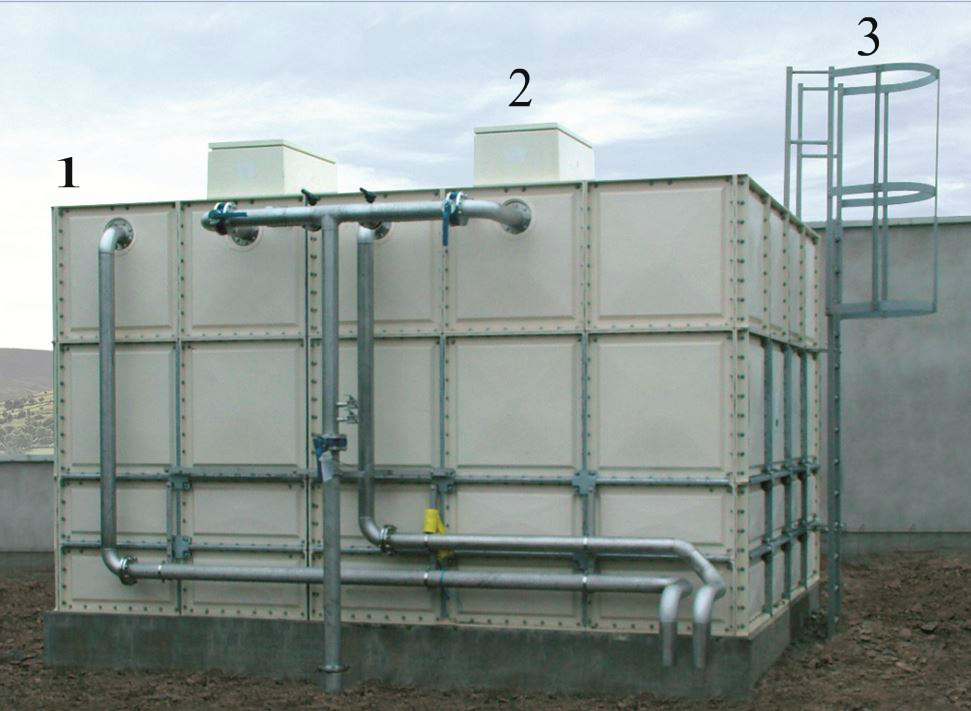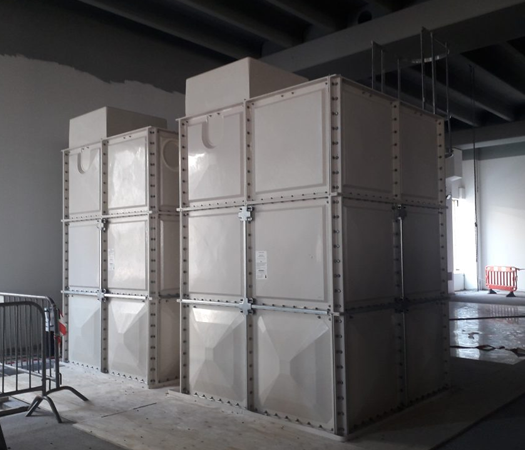SECTIONAL TANK Installation
Introduction
At Tricel, we manufacture, deliver and assemble three types of sectional water storage tanks. Standard Sectional Tank Installation has an internally flanged base and externally flanged side walls. Stainless steel is used for all underwater stays, and all outer bolts are galvanised to BS EN ISO 1461:1999. Stainless steel bolts are also available. Heavy duty cover tank installations are suitable for indoor and outdoor use and storing foul water. Lid panels on these tanks are internally flanged, just like those used in the base. Installations with heavy duty covers and finished Format 30 tanks can be used indoors and outdoors to store drinking water.
If you have any questions, feel free to call us or use our quote form
To speak to one of our agents online, click here
1000 Litre Sectional Tank Installation
Standard Sectional Tank installation comes complete with Bolts galvanised to BS EN ISO 1461:1999, and we recommend that Consultants specify Stainless Steel grade 316 S16 bolts for underwater and lid installations. When there is only one water storage tank in a building, and its capacity exceeds 1000 litres, it is recommended that a divider be installed to prevent interruptions of the water supply during repairs or maintenance. The cistern shall be provided with compartments or a standby cistern. Whenever drinking water is being stored, two separate tanks are recommended because cross contamination between sides of a wall can be challenging to detect.
Condensation trays should be used in sectional tank installation where condensation drips from pipework or the tank to prevent nuisance damage and slippery floors. Ball valve housings are an enclosed chamber containing an access hatch above the level of the cover, allowing the level control mechanism to be mounted higher than it would otherwise be.
The overflows must be placed on the tank side wall and not on the Ball Valve Housing. Water must be kept below the tank roof level. An internal ladder, as well as an external ladder, should be installed in tanks with a depth of 1m or greater. If the tank is on a raised platform, ladders may be required on tanks lower than this height where the tank is 2m or more from the top of the tank to the finished floor level. Safety cages should be installed on external ladders.
When a tank is 2m or more from the top of the tank to the finished ground level, a guardrail should be installed, enclosing all access points to the tank roof. Additional safety guards may be required for ladders depending on their location.

Height
Where height space is restricted above the tank, the side access hatch is a good choice, with an opening of 600mm x 600mm. It is available as a 1000mm x 1000mm metric panel, and it also provides more accessible access to the inside of a tank. The side access hatch has three main components: the panel, the flange, and the flat hatch sheet. To open the hatch, the flat hatch sheet is simply unbolted from the flange. The hatch can only be opened if the water level inside the tank is lower than the hatch. This Access Hatch was designed so that both the head of the bolt and the nut are accessible. A wrench can then be placed on the bolt head and the nut, preventing the bolt from spinning without opening.
Sectional Tank Assembly aftercare
After the Sectional Tanks Installation, the tank should be filled within 14 days. If a drip tray is present, ensure it has a functioning overflow so that water does not enter the surrounding area. Appropriate overflows must be fitted to the condensation tray before filling the tank. Ensure that an appropriately sized overflow and warning pipe, if required, are connected to the tank such that, if activated, they would discharge waste in a way that would prevent any damage to the surrounding area. Start filling the tank to the operational level. Monitor fill to ensure there are no weeps. Leave the tank settled for a couple of days if there is a minor weep (and it does not inconvenience the surrounding area). If weeping continues, contact the office. If a major leak occurs, shut off the water, drain down the tank and contact the office for further assistance.
Commissioning Sectional water tanks after 14 days of the end of the build or lying empty for several weeks or months is not recommended. If the tank is not commissioned within the 14 days outlined above, the tank is decommissioned for an extended period; you may need to re-torque the bolts to prevent minor weeps. We recommend the tank is filled within 14 days after build and kept full of water (except for cleaning/maintenance) throughout its operating lifespan. If draining down the water tank for maintenance, cleaning or other purposes, it must be refilled within the 14-day period specified above.
WATER TANK CAPACITY CALCULATOR
Try our free water tank calculator below
ONLINE FORM
Arrange a callback or email enquiry
Recent Projects
Extensive industry experience, manufacturing since 1973.
GRP Water Storage Tank Installations
Data Centres
Government Buildings
Airports & Hotels
Pharmaceuticals
50 YEARS IN BUSINESS
A highly successful multinational corporation with over 50 years’ valuable industry experience
FULLY CUSTOMISABLE TANKS
Tanks available for all capacities, 43 litres to 4,651,290 litres. Larger tanks available on request
FAST DELIVERY
On-time delivery is a core requirement of our successful business operations


